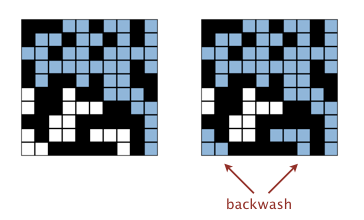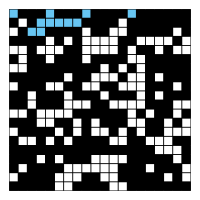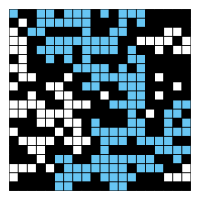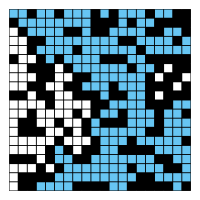Expand All
Collapse All
- Which version of Java must I use?
- Any version of Java 8 to Java 11 should be fine, provided you don’t use any exotic features.
Our autograder uses OpenJDK 11.
- Which Java programming environment should I use?
-
We recommend our customized IntelliJ programming environment for
Mac OS X,
Windows,
and
Linux.
If you followed our step-by-step
instructions, then everything should be configured and ready to go.
If you prefer to use another environment (such as Eclipse or Sublime), that’s
perfectly fine—just be sure that you know how to do the following:
- Add
algs4.jar to your Java classpath.
- Enter command-line arguments.
- Use standard input and standard output (and, ideally, redirect them to or from a file).
- How do I configure IntelliJ to access the libraries in
algs4.jar?
-
If you use the provided IntelliJ project, you should be ready to go.
Note that the provided IntelliJ project is configured to automatically add (and remove)
import statements as needed, so you
won’t type import statements explicitly.
- What’s the Project link?
-
It contains an IntelliJ project that you can use to develop your program.
It may also contain supplemental test clients and data files
(that you can use even if you do not use IntelliJ).
- I haven’t programmed in Java in a while. Which material do I need to remember?
- For a review of our Java programming model (including our input and output libraries),
read Sections 1.1 and 1.2 of Algorithms, 4th Edition.
- I’ve never programmed in Java before. Should I continue with the course?
-
That depends. You will need to write your programs in Java to receive feedback from
the autograder. Perhaps you can use this course as an opportunity to learn Java.
- Where can I find the Java source code and documentation
for the algorithms, data structures, and I/O libraries from lecture and the textbook?
- They are in
algs4.jar.
Here are links to the source code and Javadoc.
- How can I receive personalized feedback on this assignment?
-
In addition to the autograder feedback (available for free via Coursera platform),
you can pay to have a teaching assistant read and provide
personalized feedback on your submission at
codePost.
-
This service includes feedback on correctness
(e.g. to help you pinpoint why you are failing a test, and how to fix the problem)
and code quality (e.g. to help you write more human-readable and maintainable code)
from experienced reviewers who are trained specifically to provide feedback on
assignments in this course.
-
The goals of the service are to help you better understand the assignment and develop
the skills necessary to work as a professional software engineer.
-
codePost
is a service, started by former Princeton students, that connects qualified
code reviewers with Coursera students.
- How do I create a zip file for submission to Coursera?
-
Here are three approaches:
- Mac OS X.
- Select the required files in the Finder.
- Right-click and select Compress 5 Items.
- Rename the resulting file to
percolation.zip.
- Windows.
- Select the required files in Windows Explorer.
- Right-click and select Send to -> Compressed (zipped) folder.
- Rename the resulting file to
percolation (the .zip extension is automatic).
- Command line (Linux or Mac OS X or Windows Git Bash).
- Change to the directory containing the required .java files.
- Execute the command:
zip percolation.zip *.java.
- Can I add (or remove) methods to (or from) the prescribed APIs?
-
No. You must implement each API exactly as specified, with the
identical set of public methods and signatures or your assignment will not be graded.
However, you are
encouraged to add private methods that enhance the readability, maintainability,
and modularity of your program.
The one exception is
main()—you are always permitted to
add this method to test your code, but we will not call it unless we specify
it in our API.
- Why is it so important to implement the prescribed API?
-
Writing to an API is an important skill to master
because it is an essential component of modular programming,
whether you are developing software by yourself or as part of a group. When
you develop a module that properly implements an API, anyone using that module (including
yourself, perhaps at some later time) does not need to revisit the details of the
code for that module when using it.
This approach greatly simplifies writing large programs, developing
software as part of a group, or developing software for use by others.
Most important, when you properly implement an API, others can write
software to use your module or to test it.
We do this regularly when grading your programs. For example, your
PercolationStats client should work with our
Percolation data type and vice versa. If you add an extra public
method to Percolation and call them from PercolationStats,
then your client won’t work with our Percolation data type.
Conversely, our PercolationStats client may not work with your
Percolation data type if you remove a public method.
- Can my public constructor and methods have side effects that are
not described in the API?
-
No. For example, the
PercolationStats constructor must not
print to standard output (or a client would not be able to use it as a module).
We usually allow public constructors and methods to have benign side effects,
such as changing the state of a random number generator.
- Which style and bug checkers does the autograder use?
How can I configure my system to use them?
-
The autograder uses the following tools:
Here is some guidance for installing on your system.
Note that Checkstyle inspects the source code; SpotBugs inspects the compiled code.
- Will I receive a deduction if I don’t adhere to the course rules for formatting and
commenting my code?
-
The autograder (and IntelliJ) provide style feedback to help you become a better programmer.
The autograder, however, does not typically deduct for stylistic flaws.
- Can my Percolation data type assume the row and column
indices are between 0 and n−1?
-
No. The API specifies that valid row and column indices are between 1 and n.
- How do I throw a
IndexOutOfBoundsException?
- Use a
throw statement such as the following:
if (i <= 0 || i > n) throw new IndexOutOfBoundsException("row index i out of bounds");
Your code should not attempt to catch any exceptions—this will interfere
with our grading scripts.
- How many lines of code should my program be?
-
You should strive for clarity and efficiency. Our reference solution for
Percolation.java is about 70 lines, plus a test client.
If you are re-implementing the union–find data structure
(instead of reusing the implementations provided), you are on the wrong track.
- After the system has percolated, my
PercolationVisualizer colors in light blue
all sites connected to open sites on the bottom (in addition to those connected to open sites
on the top). Is this “backwash” acceptable?
-
No, this is likely a bug in
Percolation. It is only a minor deduction
(because it impacts only the visualizer and not the experiment to estimate
the percolation threshold), so don’t go crazy trying to get this detail.
However, many students consider this to be the most challenging and creative
part of the assignment (especially if you limit yourself to one union–find object).
~/Desktop/percolation> java-algs4 PercolationVisualizer input10.txt

- What should
stddev() return if trials equals 1?
-
The sample standard deviation is undefined. We recommend returning
Double.NaN.
- How do I generate a site uniformly at random among all blocked sites?
-
Pick a site at random (by using
StdRandom to generate two
integers between 1 and n) and use this site if it is blocked; if not, repeat.
- How precisely must the output in
main() match the format given?
-
It should match exactly except that the autograder ignores whitespace and allows
fewer digits of precision after the decimal point.
- I don’t get reliable timing information when n = 200. What should I do?
-
Increase the size of n (say to 400, 800, and 1600), until
the mean running time exceeds its standard deviation.
Testing
Testing.
We provide two clients that serve as large-scale visual traces.
We highly recommend using them for testing and debugging your
Percolation implementation.
Visualization client.
PercolationVisualizer.java animates the
results of opening sites in a percolation system specified by a file by performing the following steps:
-
Read the grid size n from the file.
-
Create an n-by-n grid of sites (initially all blocked).
-
Read in a sequence of sites (row i, column j) to open from the file.
After each site is opened, draw full sites in light blue, open sites (that aren’t full) in white, and
blocked sites in black using standard draw, with with site (1, 1) in the upper left-hand corner.
The program should behave as in
this movie and the following snapshots
when used with input20.txt.
% java PercolationVisualizer input20.txt
|
| 
50 open sites
| 
100 open sites
| 
150 open sites
| 
204 open sites
| 
250 open sites
|
Sample data files.
The zip file
percolation.zip
contains some sample files for use with the visualization client.
Associated with each input .txt file is an output .png file that contains the
desired graphical output at the end of the animation.
InteractiveVisualization client.
InteractivePercolationVisualizer.java is similar
to the first test client except that the input comes from a mouse (instead of from a file).
It takes an integer command-line argument n that specifies the lattice size.
As a bonus, it writes to standard output the sequence of sites opened in the same format used by
PercolationVisualizer, so you can use it to prepare interesting files for testing.
If you design an interesting data file, feel free to share it with us and your classmates by posting it
in the discussion forums.
Possible Progress Steps
These are purely suggestions for how you might make progress. You do
not have to follow these steps.
- Consider not worrying about backwash for your first attempt.
If you’re feeling overwhelmed, don’t worry about backwash when following the possible progress steps below. You
can revise your implementation once you have a better handle on the problem and have solved the problem without
handling backwash.
- For each method in
Percolation that you must implement
(open(), percolates(), etc.), make a list of which WeightedQuickUnionUF
methods might be useful for implementing that method.
This should help solidify what you’re attempting to accomplish.
- Using the list of methods above as a guide, choose instance variables that
you’ll need to solve the problem.
Don't overthink this, you can always change them later. Instead, use your list of instance variables to guide
your thinking as you follow the steps below, and make changes to your instance variables as you go. Hint: At
minimum, you'll need to store the grid size, which sites are open, and which sites are connected to which other
sites. The last of these is exactly what the union–find data structure is designed for.
-
Plan how you're going to map from a 2-dimensional (row, column) pair
to a 1-dimensional union find object index.
You will need to come up with a scheme for uniquely
mapping 2D coordinates to 1D coordinates. We recommend writing a private method with a
signature along the lines of
int xyTo1D(int, int) that performs this conversion. You
will need to utilize the percolation grid size when writing this method. Writing such a
private method (instead of copying and pasting a conversion formula multiple times throughout
your code) will greatly improve the readability and maintainability of your code. In general,
we encourage you to write such modules wherever possible. Directly test this method using the
main() function of Percolation.
- Write a private method for validating indices.
Since each method is supposed to throw an exception for invalid indices, you should write a private
method which performs this validation process.
- Write the
open() method and the Percolation() constructor.
The open() method should do three things. First, it should validate the indices of the site that it
receives. Second, it should somehow mark the site as open. Third, it should perform some sequence of
WeightedQuickUnionUF operations that links the site in question to its open neighbors.
The constructor and instance variables should facilitate the open() method's ability to
do its job.
- Test the
open() method and the Percolation() constructor.
These tests should be in main(). An example of a simple test is to call
open(1, 1) and open(1, 2), and then to ensure that the two corresponding
entries are connected (using two calls to find() in WeightedQuickUnionUF).
- Write the
percolates(), isOpen(), and isFull() methods.
These should be very simple methods.
- Test your complete implementation using the visualization clients.
- Write and test the PercolationStats class.
Programming Tricks and Common Pitfalls
-
Do not write your own union–find data structure. Use
WeightedQuickUnionUF instead.
-
Your
Percolation class must use
WeightedQuickUnionUF.
Otherwise, it will fail the timing tests, as the autograder intercepts and counts calls to methods in
WeightedQuickUnionUF.
-
It's OK to use an extra row and/or column to deal with the 1-based indexing of the percolation grid.
Though it is slightly inefficient, it's fine to use arrays or union–find objects that are slightly larger
than strictly necessary. Doing this results in cleaner code at the cost of slightly greater memory usage.
-
Each of the methods (except the constructor) in
Percolation must use a constant
number of union–find operations.
If you have a for loop inside of one of your
Percolation methods, you're probably doing it wrong. Don't forget about the virtual-top /
virtual-bottom trick described in lecture.
 Percolation
Percolation





